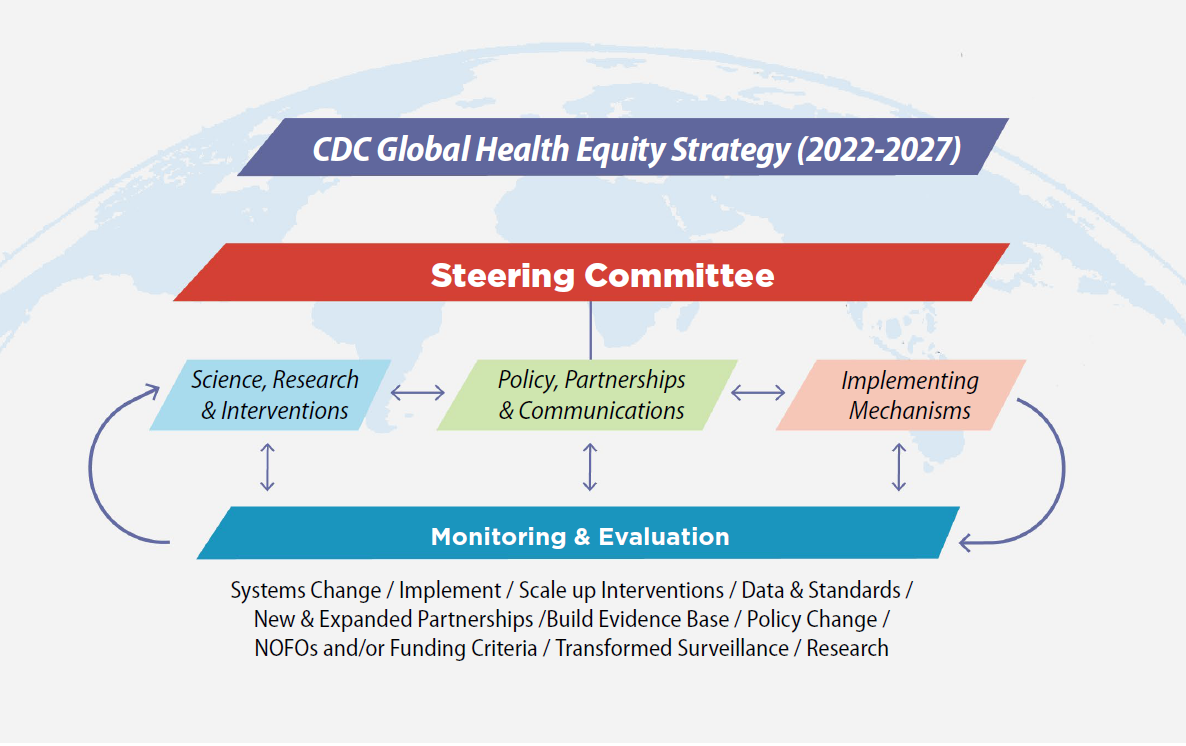Implementing CDC’s Global Health Equity Strategy
The CDC global health equity implementation plan details an approach to identify resources, operationalize, and measure progress towards achieving health equity goals in our global work. It formalizes collaborations and decision-making towards health equity in CDC’s global work to accelerate progress and make reaching our global health equity goals deliberate and purposeful in our science, interventions, partnerships, and infrastructure. The process of global health equity implementation will involve, but is not limited, to the following:

Measuring progress and investments towards CDC’s global health goals and the impact of CDC’s global support to those who need it most

Identifying, integrating, and/or advancing existing and cross-cutting objectives, activities and other investments in global work that contribute to achieving our global health equity goals

Institutionalizing cross-CIO collaborative processes so that CDC’s contributions to health equity are clearly identified and measurable
To achieve the global health equity goals outlined in this strategy, the implementation plan proposes a structure that engages and is inclusive of all programs doing global work across the agency and within country offices2. Grounded in CDC’s CORE themes, a steering committee will provide high-level decision making and direction for CDC’s global health equity implementation plan. The steering committee is composed of senior-level leadership able to make decisions to guide four workstreams that reflect the operational structure of CDC science, programs, and policy. The workstreams align with CDC’s CORE commitment to health equity and the overarching themes associated with these CORE goals. The workstreams are intended to maintain and formalize consistent cross-center coordination to assure common objectives and support for implementation in order to build upon and advance CDC’s vision for global health equity. Implementation activities will also apply and reinforce the Essential Components to Achieving the Highest Attainable Level of Health and our six guiding principles that help direct and sustain focus on the implementation of health equity into global activities.
The following describes the four implementation workstreams and purpose:
- Monitoring & Evaluation – Track and monitor progress, performance, and success of health equity in our global work, evaluate the effectiveness and impact of CDC’s global programs for those who need it the most, and identify existing or needed data that will monitor and inform our ongoing health equity strategies
- Science, Research & Interventions – Ensure CDC’s Health Equity Science Principles are integrated into all global science/research agendas, methodologies, and implementation, use scientific findings, innovative approaches, and data-driven strategies to develop and/or build upon interventions that address the drivers of health disparities
- Partnerships, Policy & Communications – Coordinate and align shared priorities and potential collaborations for impactful implementation, integrate and/or highlight health equity principles in policy recommendations and guidance, and incorporate and advance health equity through respectful and thoughtful communication
- Implementing Mechanisms – Implement global health equity strategies through internal/external fiscal mechanisms to ensure effective, efficient and coordinated allocation of resources
Proposed Global Health Equity Implementation Structure
2Other CIOs may conduct additional global activities aimed at reducing health disparities that will also support the goals of CDC’s Global Health Equity Strategy
